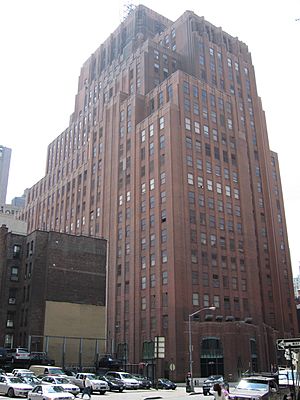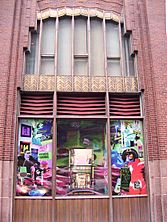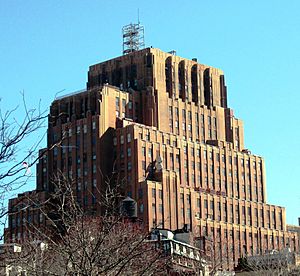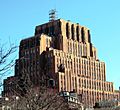60 Hudson Street facts for kids
Quick facts for kids 60 Hudson Street |
|
|---|---|
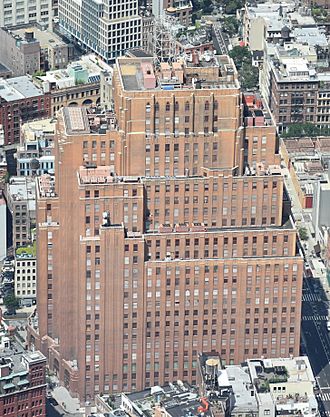
View of 60 Hudson Street from One World Observatory
|
|
| Former names | Western Union Building |
| General information | |
| Location | 60 Hudson Street Manhattan, New York |
| Coordinates | 40°43′04″N 74°00′30″W / 40.71778°N 74.00833°W |
| Construction started | 1928 |
| Completed | 1930 |
| Designated: | October 1, 1991 |
| Reference #: | 1749 (exterior) 1750 (interior) |
| Height | 371 feet (113 m) |
| Technical details | |
| Floor count | 24 |
| Design and construction | |
| Architect | Ralph Thomas Walker |
| Architecture firm | Voorhees, Gmelin and Walker |
60 Hudson Street, once known as the Western Union Building, is a special building in the Tribeca area of Manhattan, New York City. It was built between 1928 and 1930. This building is one of many Art Deco-style buildings designed by Ralph Thomas Walker in the early 1900s. It takes up a whole city block, bordered by Hudson Street, Thomas Street, Worth Street, and West Broadway.
60 Hudson Street stands 371 feet (113 m) tall and has 24 floors. Its design mixes Dutch and German Expressionism styles with cool Art Deco details. The building has an interesting shape with different sections and many setbacks (steps back from the street). Its brick outside changes color from dark at the bottom to light at the top, using 19 different shades. There are also fancy entrances at street level that lead to a curved brick lobby.
This building was first the main office for Western Union, a big telegraph company. When it opened, it was called the world's largest telegraph building. It brought together all of Western Union's different offices from around New York City. Even though Western Union moved out in 1973, the building is still a major communication hub. Since the late 1900s, it has become a colocation center, making it one of the most important Internet centers in the world. The outside and the lobby of 60 Hudson Street were made official New York City landmarks in 1991.
Contents
Building Design and Features
60 Hudson Street is 371 feet (113 m) tall and has 24 stories. It sits on a unique, trapezoid-shaped piece of land. The building was designed by Ralph Walker of Voorhees, Gmelin and Walker. He used the popular Art Deco style. This was one of several important communication buildings Walker designed in New York City.
Building's Shape
The shape of 60 Hudson Street includes many setbacks. These steps back were required by city rules to let more light and air reach the streets below. They also became a key part of the Art Deco look. Even though the land is trapezoid-shaped, the building uses mostly rectangular sections. Walker wanted the building to have its own unique form, no matter the shape of the land. He designed it as a series of connected blocks, like a "manmade mountain."
The side facing Hudson Street has a two-story "screen" with three rectangular sections rising behind it. The other sides, like West Broadway, are more even. The setbacks on these sides create a stepped look as the building goes higher. The building's shape was also planned for its inside uses. It had offices and special equipment areas. Some parts, like the main operating system, didn't need sunlight, so they were placed in the middle of the building. Offices were placed near the windows.
Outside Look (Facade)
The outside of 60 Hudson Street is made of brick. Walker chose brick for its texture and how it could be used in many colors. The building's design uses strong vertical lines and setbacks, making it look like a series of waterfalls. Most of the decorations on the outside are also made of brick, especially near the bottom. This style was influenced by Dutch and German Expressionism.
The bricks come in 19 different shades of red. They are arranged to create a gradient, meaning they go from darker bricks at the bottom to lighter bricks at the top. This was one of the first buildings to use bricks in this way. The different shades of brick help show off the building's unique shape. Some people said it looked like "a huge red rock projecting out of the city."
Base of the Building
The bottom two floors make up the base of the building. The very bottom part is made of pink granite. Above that, the brick outside begins. Around the doors and windows, the brickwork looks like draped curtains. Most of the decorations are brick, but the window frames and doorways are made of bronze.
On the Hudson Street side, there's a large main entrance with five bronze doors. Above the doors is a window with diagonal lines. Other entrances on Hudson Street have shops on the ground floor and curtain-shaped windows on the second floor. The West Broadway side has a similar main entrance. The Worth Street side has shop windows and special triple-hung windows that hid an auditorium inside. On Thomas Street, there are loading docks and windows.
Upper Floors
The upper floors of 60 Hudson Street have a consistent look. On Hudson Street, the outside has a pattern of wide and narrow vertical sections. On the other sides, these sections are mostly flat, except behind the setbacks where they stick out more. Some parts of the north and south sides have no windows, hiding stairways.
Inside Spaces
Walker designed the inside of 60 Hudson Street to work like a "machine" for its users. The inside style matches the outside, which was unusual for buildings at that time. The decorations inside are simpler and mostly use brick. The building's interior spaces cover almost 1 million square feet (93,000 m2).
Lobby Area
The main lobby is a 25-foot-wide (7.6 m) hallway that goes from Hudson Street to West Broadway. It's usually not open to the public. The hallway has a curved, barrel-vaulted brick ceiling, like the inside of a church. Off this main hallway are elevators and other doors leading to service areas and stairwells.
Unlike many other Art Deco lobbies, which used old-fashioned designs, 60 Hudson Street's lobby has a modern brick look. It's mostly covered in brick and tile, with granite at the bottom of the walls. A Western Union book said it was the "only all-brick corridor in any office building in America." Many details from the outside, like brick patterns and bronze trim, are also used in the lobby.
Other Rooms
The second floor of the building once had a gym, a library, and a school for training messengers. The upper floors held offices, equipment rooms, and mechanical shops. The ninth floor had company laboratories, and the 24th floor was a "presidential suite." Floors 11 through 15 were used for Western Union's different communication systems, like Morse code and telephone equipment. This showed how important 60 Hudson Street was as the "heart of a nerve system" connecting the nation and the world.
The building had a huge amount of cable and pipes, plus its own power plant. Pneumatic tubes (tubes that send mail using air pressure) connected 60 Hudson Street to 25 other offices in Manhattan. These tubes were later used to hold wires for the Internet companies that moved into the building.
History of 60 Hudson Street
Early Plans
Western Union started in 1851 and became a leading telegraph company. In 1875, they built their first main office at 195 Broadway. Later, in 1909, AT&T bought Western Union. AT&T then built a new headquarters at the same Broadway location, finished in 1916. By the 1920s, Western Union needed its own main building again.
AT&T later sold its shares in Western Union in 1913. Under its president, Newcomb Carlton, Western Union grew and updated its technology.
Building Construction
Western Union began buying land for 60 Hudson Street in 1924, eventually owning the entire block. The location was chosen because it was close to other Western Union offices and important clients in Lower Manhattan, like the stock exchanges.
In May 1928, Western Union submitted plans for the building. Construction began in August 1928. The building was expected to be finished by January 1930. The construction was complex because the building needed to be fireproof and secure. It also had to handle 100 million messages each year.
Western Union Era
Western Union started moving into 60 Hudson Street in August 1930. On October 5, the telegraph lines from another office were successfully moved to 60 Hudson Street. This was a huge engineering feat because telegraph service continued without stopping during the 12-hour move.
The Western Union Building became a central point for worldwide communications during the time of the telegraph. It was called the "Telegraph Capitol of America." The building's equipment was always updated with the newest technology. In 1948, Western Union sold the building but continued to rent space there. This helped them pay for new equipment.
Western Union moved its main office to New Jersey in 1973. They slowly moved out of 60 Hudson Street completely by 1983. However, 60 Hudson Street remained a very important telecommunications center. Wires from many long-distance communication companies met there.
Internet Hub Today
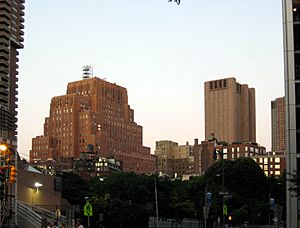
After Western Union left, 60 Hudson Street became a colocation center. It grew into one of the most important internet hubs in the world. Hundreds of telecom companies connect their Internet networks here. They use special "meet-me rooms" and many cables throughout the building. Many companies that provide data center services are tenants in the building.
In 1991, the outside and ground-floor lobbies of 60 Hudson Street were named city landmarks. This protected their unique design.
After Western Union moved out, some city and state government offices used space in the building. For example, the New York City Department of Correction moved there in 2002. However, these offices later moved out, and the space was then used by Internet companies.
There have been some concerns about the building's use as a colocation center. In 1999, neighbors complained that the cooling systems were too loud. The building's owners agreed to reduce the noise. In 2006, a city group approved storing diesel fuel on some floors. Some people worried about fire safety, but the building continues to operate. 60 Hudson Street also started some renovations in 2015.
Images for kids
See also
 In Spanish: 60 Hudson Street para niños
In Spanish: 60 Hudson Street para niños


